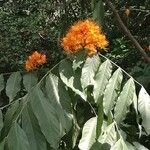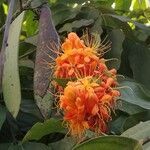Trees, 5-20 m tall. Trunk ca. 25 cm d.b.h. Petiolules 7-12 mm; leaflets 5 or 6 pairs, slightly purplish red when young, pendulous, narrowly elliptic, ovate-lanceolate, or narrowly obovate, 15-35 × 5-12 cm, subleathery, lateral veins 8-11 pairs, lowest pair often smaller, base cuneate, apex acuminate, acute, or obtuse. Inflorescence axillary, larger; rachis hairy or glabrous; involucre caducous, broadly ovate, large, hairy; bracts caducous or late deciduous, ovate, lanceolate, or oblong, 1.5-5 × 0.6-2 cm, lowest one largest, gradually smaller upward, hairy or glabrous; bracteoles equal to bracts in shape but much smaller. Flowers bisexual or unisexual, yellow, base of calyx lobes, disk, stamens, and style becoming red; pedicels shorter than calyx tube, not articulate. Calyx tube 1.5-3 cm; lobes 4(-6), oblong, ciliate. Stamens 8-10 including 1 or 2 often reduced to subulate; filaments exserted; anthers oblong, 3-4 mm. Ovary slightly curved, glabrous or hairy along sutures and stalk. Legume brownish, compressed, 22-30 × 5-7 cm, valves twisted. Seeds 5-9, unequal in shape, shallowly depressed sulcate at middle of both surfaces. Fl. Apr-May, fr. Jul-Oct.
More
A tree. It grows to 7-20 m tall. The trunk is 25 cm across. The leaves have 5 or 6 pairs of leaflets. They hang down. They are oval and 15-35 cm long by 5-12 cm wide. The flowers are yellow but do not have petals. The fruit or pod is on 4 cm long stalks. The pod is 22-30 cm long by 5-7 cm wide. The valves are twisted. There are 5-9 seeds.
Can be grown by seedlings. Seeds needs soaking.


